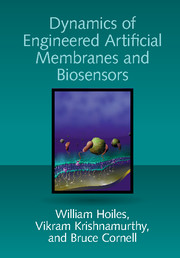Book contents
- Frontmatter
- Contents
- Preface
- List of Abbreviations
- Part I Introduction and Background
- Part II Building Engineered Membranes, Devices, and Experimental Results
- Part III Dynamic Models for Artificial Membranes: From Atoms to Device
- 8 Reaction-Rate-Constrained Models for Engineered Membranes
- 9 Reaction-Rate-Constrained Models for the ICS Biosensor
- 10 Diffusion-Constrained Continuum Models of Engineered Membranes
- 11 Electroporation Models in Engineered Artificial Membranes
- 12 Electroporation Measurements in Engineered Membranes
- 13 Electrophysiological Response of Ion Channels and Cells
- 14 Coarse-Grained Molecular Dynamics
- 15 All-Atom Molecular Dynamics Simulation Models
- 16 Closing Summary for Part III: From Atoms to Device
- Appendices
- Bibliography
- Index
12 - Electroporation Measurements in Engineered Membranes
from Part III - Dynamic Models for Artificial Membranes: From Atoms to Device
Published online by Cambridge University Press: 25 May 2018
- Frontmatter
- Contents
- Preface
- List of Abbreviations
- Part I Introduction and Background
- Part II Building Engineered Membranes, Devices, and Experimental Results
- Part III Dynamic Models for Artificial Membranes: From Atoms to Device
- 8 Reaction-Rate-Constrained Models for Engineered Membranes
- 9 Reaction-Rate-Constrained Models for the ICS Biosensor
- 10 Diffusion-Constrained Continuum Models of Engineered Membranes
- 11 Electroporation Models in Engineered Artificial Membranes
- 12 Electroporation Measurements in Engineered Membranes
- 13 Electrophysiological Response of Ion Channels and Cells
- 14 Coarse-Grained Molecular Dynamics
- 15 All-Atom Molecular Dynamics Simulation Models
- 16 Closing Summary for Part III: From Atoms to Device
- Appendices
- Bibliography
- Index
Summary
Introduction
The electroporation measurement platform (EMP) discussed in Chapters 4 and 6 is a synthetic biological device built out of artificial membranes to study electroporation in a controlled environment. In this chapter we apply the continuum models for electroporation developed in Chapter 11 to predict and interpret the response of the EMP device. Specifically we evaluate how accurately the continuum models predict the response of the EMP to membranes containing different tether densities, lipid types, and sterols and excited using different waveforms. Thus, this chapter (which validates electroporation models with experimental data in precisely controlled environments) together with the previous chapter (which formulates continuum models) gives a complete treatment of electroporation at the mesoscopic level.
Before proceeding, the reader should recall that electroporation is the process of aqueous pore formation resulting from changes in the transmembrane potential. A schematic of the electroporation process is given in Figure 12.1. To ensure only the process of electroporation is present, the following test is performed for all experiments involving the electroporation measurement platform (see Chapter 6 for details of such experiments). An excitation potential Vs is applied and the resulting current is recorded; then the negative potential −Vs is applied and the resulting current recorded. If the current response resulting from Vs is related to the current response of −Vs by a sign change then we can conclude that only the process of electroporation is present. This conclusion follows from the dynamic model of engineered membranes given by Figure 11.4 and (11.17). Recall that the process of electroporation is transmembrane potential symmetric; that is, the polarity or sign of the applied transmembrane potential does not change the dynamics the electroporation process. All experimental measurements reported below satisfied this test.
Organization of Chapter
Given the mesoscopic models in Chapter 11, in this chapter we evaluate important parameters of the engineered membrane using both in silico and in vitro techniques. More importantly, we give significant insight into the process of electroporation by discussing several aspects.
Figure 12.2 illustrates the aspects of electroporation that we discuss, which comprises three topics. The first is the aqueous pore conductance and dynamics (number and size of aqueous pores).
- Type
- Chapter
- Information
- Dynamics of Engineered Artificial Membranes and Biosensors , pp. 250 - 281Publisher: Cambridge University PressPrint publication year: 2018



